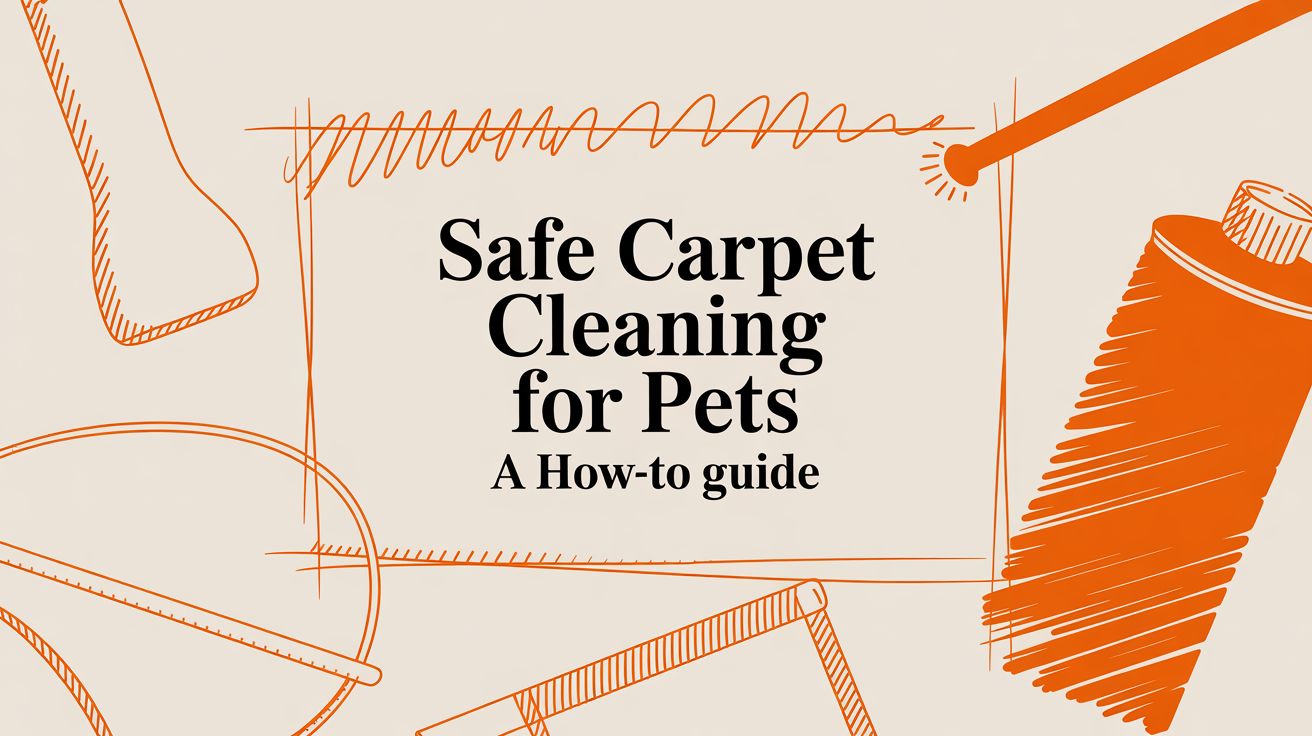That "fresh and clean" scent from standard carpet cleaners? It often hides ingredients that can be seriously harmful to your pets. A lot of the store-bought formulas are packed with chemicals like ammonia, chlorine, and phthalates, which can cause problems through skin contact, inhalation, and even ingestion. Choosing a genuinely safe carpet cleaning method isn't just a preference—it's a critical part of being a responsible pet owner.
The Hidden Dangers in Common Carpet Cleaners
When you use a conventional carpet cleaner, you're not just tackling stains; you might be laying down a minefield of toxins right where your pets live. Animals are uniquely vulnerable because they're so close to the floor. They breathe in the fumes, absorb chemicals through their paw pads, and then lick those chemicals off when they groom themselves.
I’ve heard countless stories about this. One common scenario involves a dog that suddenly develops angry, red skin after rolling around on a freshly cleaned rug. Another might be a cat that starts wheezing or coughing because of harsh chemical vapors lingering in the air. These aren't just one-off incidents; they show the direct, and sometimes immediate, impact of certain cleaning agents.
Understanding the Chemical Threats
Many popular cleaning products contain compounds that are known irritants—or worse. The main offenders you need to watch out for are:
- Ammonia: A powerful but caustic agent that can really irritate your pet’s respiratory tract and eyes.
- Chlorine: It’s often used as a disinfectant, but its fumes can be damaging to a pet’s sensitive lungs.
- Phthalates: These are often hidden in synthetic fragrances to make things smell "clean" and have been linked to a whole host of health issues.
This infographic breaks down just how prevalent these chemicals are in many household carpet cleaners.
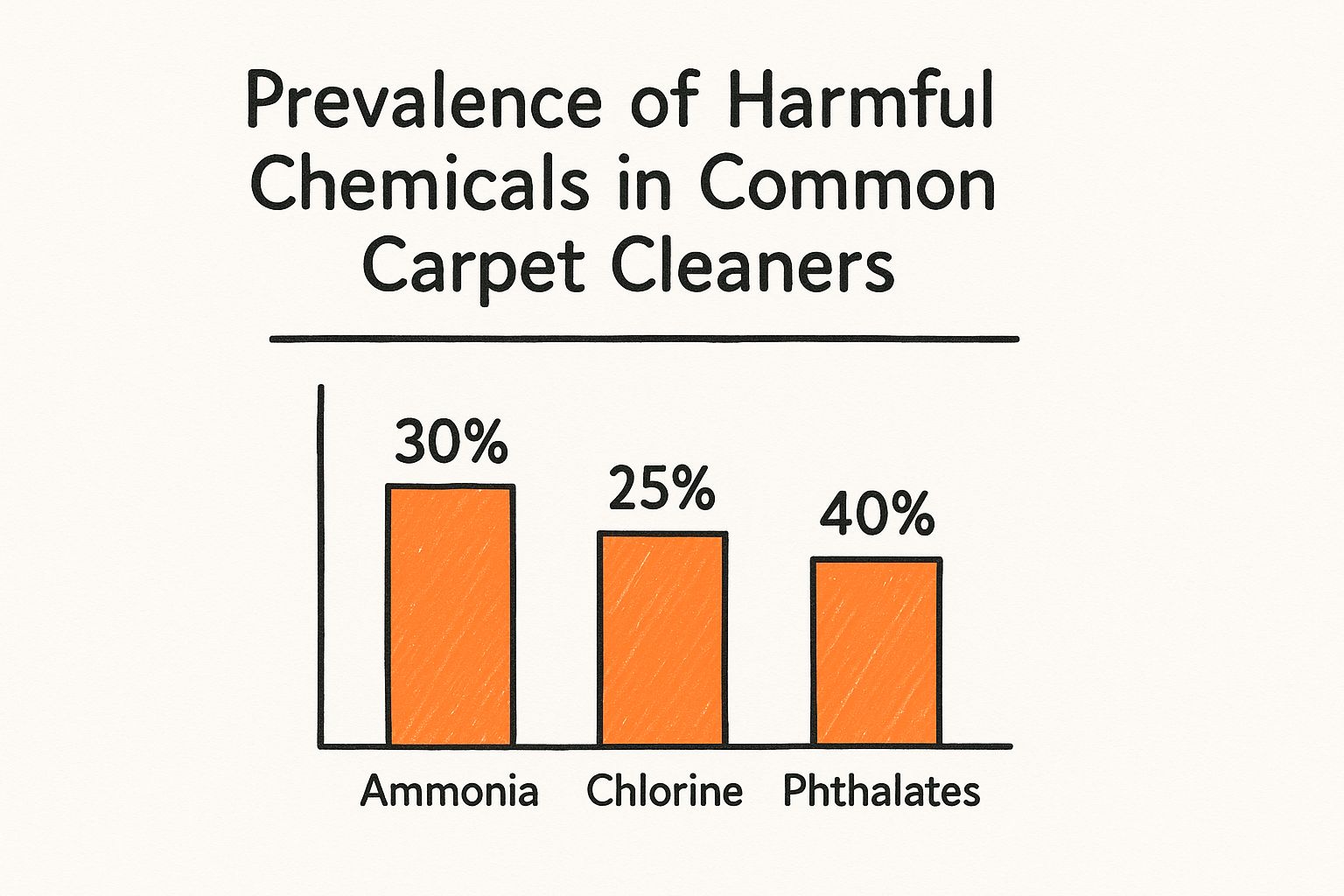
The numbers don't lie. A huge chunk of cleaning products relies on these potentially harmful ingredients, which makes reading the label an absolute must for any pet parent. It's no surprise that people are catching on and the global market for pet-safe cleaning products is blowing up.
Pet safety is finally becoming a top priority for consumers. The market for pet cleaning products, which includes safe carpet cleaning solutions, was valued at USD 6.75 billion in 2024 and is projected to hit USD 9.85 billion by 2033.
This trend shows a massive shift toward plant-based and enzyme-based formulas that put health ahead of harsh chemicals. Truly understanding why certain carpet cleaning methods can be a health concern is the first real step toward creating a safer home for everyone.
Common Cleaning Chemicals vs Pet-Safe Alternatives
It can be tough to know what's safe and what isn't just by reading a label. Here’s a quick breakdown of the bad stuff and the good stuff to look for.
| Harmful Chemical | Potential Risk to Pets | Safe Alternative |
|---|---|---|
| Ammonia | Respiratory irritation, eye damage, skin burns | Baking Soda & Vinegar |
| Chlorine Bleach | Lung damage, nausea, gastrointestinal issues | Hydrogen Peroxide |
| Phthalates | Endocrine disruption, allergic reactions | Essential Oils (Pet-Safe) |
| Perchloroethylene | Liver & kidney damage, neurological effects | Plant-Based Solvents (like D-Limonene) |
| Formaldehyde | Cancer risk, severe respiratory irritation | Enzyme Cleaners |
Switching to products with these safer alternatives isn't just a small change—it's a significant upgrade for your home's health and your pet's well-being.
Choosing Your Pet-Friendly Cleaning Method
Once you understand the risks lurking in common cleaning chemicals, the next logical step is picking a method that's both effective and genuinely safe for your pets. This isn't a one-size-fits-all situation. The right choice really depends on your carpet type, how sensitive your pets are, and the kind of messes you’re dealing with on a daily basis.
Frankly, not all "safe" methods are created equal. Knowing the difference is what gets you a truly clean, healthy home versus just a surface-level clean.
In the pet-friendly cleaning world, two main approaches stand out: hot water extraction (what most people call steam cleaning) and very low-moisture (VLM) systems. Each one has its own set of pros for pet owners.
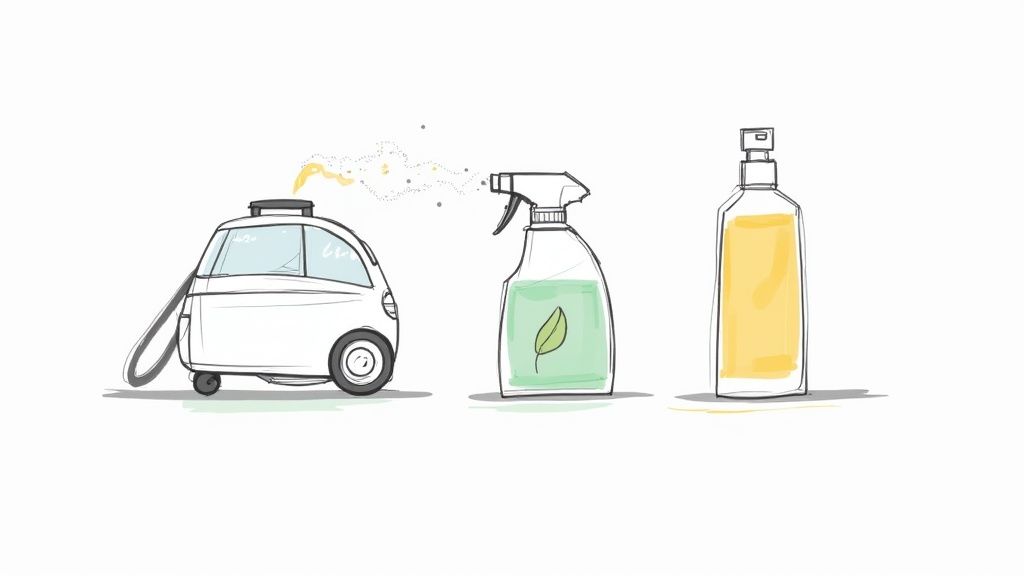
Hot Water Extraction: The Deep Clean Option
Hot water extraction is the heavy hitter. It uses high-pressure hot water to really get in there and agitate the carpet fibers, dissolving all that deep-down dirt, grime, and pet dander. Then, a powerful vacuum sucks up the dirty water and gunk, leaving very little behind when it's done right. This method is fantastic for a serious deep clean to get rid of allergens.
It's no surprise this technique is gaining traction, especially with pet owners. The global market for carpet extraction cleaners hit USD 1.10 billion in 2024 and is expected to climb to USD 1.75 billion by 2032. Why? Because it offers a deep clean without having to douse your home in harsh chemicals.
Low-Moisture Systems: The Fast and Fresh Approach
On the other side of the coin, you have very low-moisture (VLM) systems, like the citrus-based method we use. These give you a powerful clean but use way less water. This is a huge win for busy households with pets because it means your carpets are dry in just a couple of hours.
These systems rely on plant-based cleaners to break down soils. The best part? They don't leave behind a sticky, soapy residue that actually attracts more dirt over time—a common problem with traditional cleaners.
If you want to see a full breakdown of how these two powerhouse methods stack up, check out our guide on low-moisture VLM versus traditional steam cleaning.
The Gold Standard for Stains: Enzyme Cleaners
When you're dealing with specific pet accidents like urine or vomit, nothing—and I mean nothing—beats an enzyme cleaner. These things are remarkable. They use beneficial bacteria to create enzymes that literally break down the organic proteins in the mess, completely wiping out the stain and the odor at a molecular level instead of just covering it up.
So what's the best approach? Honestly, it’s often a combination. For a great overview on how to choose and use methods that are safe for your furry family members, you can explore these expert tips and tricks for safe carpet cleaning for pets. A VLM clean is perfect for regular maintenance to keep things fresh, while an occasional hot water extraction can hit the reset button on your carpets.
Your DIY Guide to Pet-Safe Carpet Cleaning
Ready to tackle some pet messes on your own? It's actually easier than you think to whip up a pet-safe carpet cleaner that works, and it lets you skip the harsh chemicals you'll find in most store-bought stuff. All you need are a few household staples to handle fresh accidents and keep things looking good between professional cleanings.
Before you even think about mixing a cleaning solution, you’ve got to do the prep work. This is non-negotiable. The very first thing you need to do is give your carpet a really thorough vacuuming. Don't be shy—spend extra time on those high-traffic areas where fur, dander, and dirt love to party.
Got stubborn pet hair that seems woven into the carpet fibers? Grab a rubber squeegee or a stiff-bristled brush. A few passes will pull that hair right up, making it easy to vacuum away. This clears the battlefield so your cleaner can attack the stain directly, not just a layer of surface gunk.
Creating Your Go-To DIY Solution
For a simple but surprisingly powerful cleaner, you just need two things you probably already have: white distilled vinegar and baking soda. These kitchen workhorses are fantastic for knocking out odors and lifting stains, all without putting your furry friends at risk.
Here’s a reliable recipe to get you started:
- Mix: Combine equal parts white vinegar and warm water in a clean spray bottle.
- Apply: Lightly mist the stained area. You don't want to soak it—oversaturating the carpet can trap moisture deep in the pad, which is a recipe for mildew.
- Dwell: Let that solution sit for about five to ten minutes. This gives the vinegar time to work its magic and break down the stain.
Crucial Tip: Always, and I mean always, do a spot test first. Pick a hidden area, like inside a closet or under the sofa, and apply a small amount of your DIY mix. You need to be sure it won't bleach or damage your specific carpet fibers before you go spraying it in the middle of the room.
Once the vinegar solution has had time to work, grab a clean, dry cloth and start blotting. Whatever you do, don't scrub! Scrubbing just grinds the stain deeper and can fray your carpet fibers. Just apply firm, steady pressure to soak up as much of the liquid as you can.
Finishing the Job Right
To deal with any lingering smells, sprinkle a light layer of baking soda over the still-damp spot. Let it sit for at least an hour—or even overnight if you're dealing with a really funky odor. The baking soda will absorb whatever scent is left.
When time's up, vacuum the area thoroughly to get all the powder up.
Finally, you need to get it dry. Proper drying is the key to preventing that musty mildew smell and ensuring a truly clean finish. Point a fan directly at the treated spot to speed things up. Good airflow will evaporate any leftover moisture, making the area dry and safe for your pets to get back to their favorite nap spot that much faster.
How to Handle Tough Pet Stains and Odors
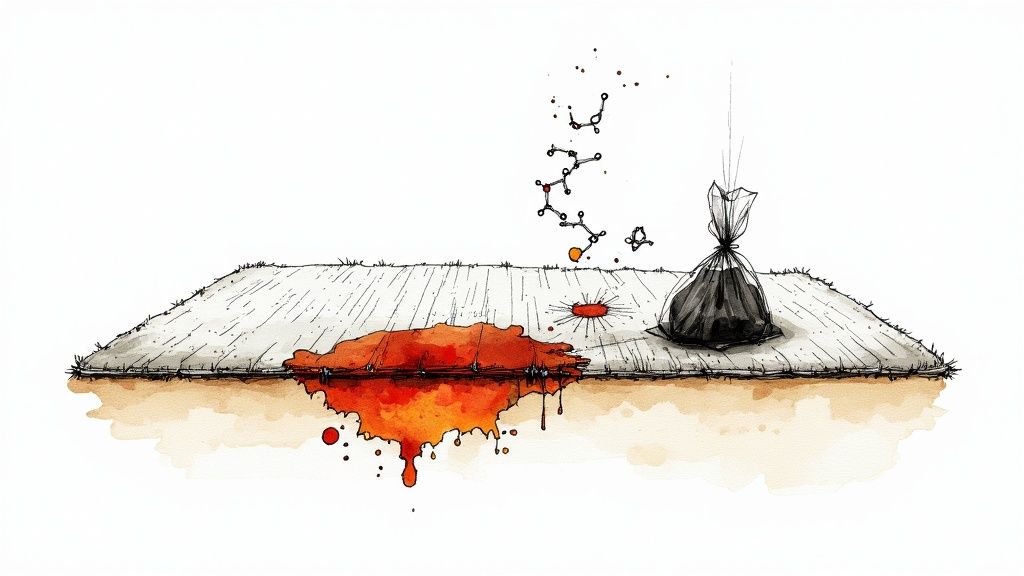
Let's be real—sometimes, a standard cleaning just doesn't make the cut. We're talking about those stubborn, set-in messes that have become part of the furniture. The old urine stain you just discovered, or that lingering wet dog smell that welcomes you at the door.
For these tough jobs, you need a different strategy. It's less about scrubbing and more about understanding the science behind the mess. For some excellent tips on this, check out this guide on removing pet stains from carpet.
Your absolute best friend in this fight is a good enzymatic cleaner. Forget regular soaps; they just move dirt around. Enzymatic solutions are different. They use beneficial bacteria that literally break down and digest the organic proteins found in things like urine, vomit, and feces. They don't just cover up the smell—they eliminate the source for good.
Targeting Specific Odors and Stains
When it comes to pet urine, the main villain is uric acid. This stuff isn't water-soluble and can hang around for years, causing odors to flare up on humid days. An enzyme cleaner is really the only thing that can truly neutralize it.
For other common pet-related issues, you might already have what you need right in your pantry.
- That "Wet Dog" Smell: If your carpet just smells a bit musty or doggy, grab some baking soda. Sprinkle a generous layer over the dry carpet, let it sit for a few hours (or even overnight), and then vacuum it up thoroughly.
- Fresh, Minor Accidents: After you’ve blotted up as much of the liquid as possible with a cloth, a simple vinegar-and-water mix can help disinfect. But honestly, reaching for the enzymatic cleaner is always the better move to stop your pet from re-marking the spot.
The core idea behind safe carpet cleaning for pets is simple: attack the stain's chemistry, not just what you see on the surface. When you eliminate the odor-causing bacteria, you break that frustrating cycle of your pet returning to the same spot.
For more persistent problems, sometimes you need to bring in bigger equipment. It's no surprise the global market for portable pet carpet cleaners hit USD 2.1 billion in 2024. These machines are fantastic for getting a deeper clean without having to resort to harsh chemicals.
If you're dealing with odors that just won't quit, our in-depth guide explains professionally-tested methods for how to get rid of pet odor in carpet for good.
Vetting a Pet-Friendly Cleaning Service
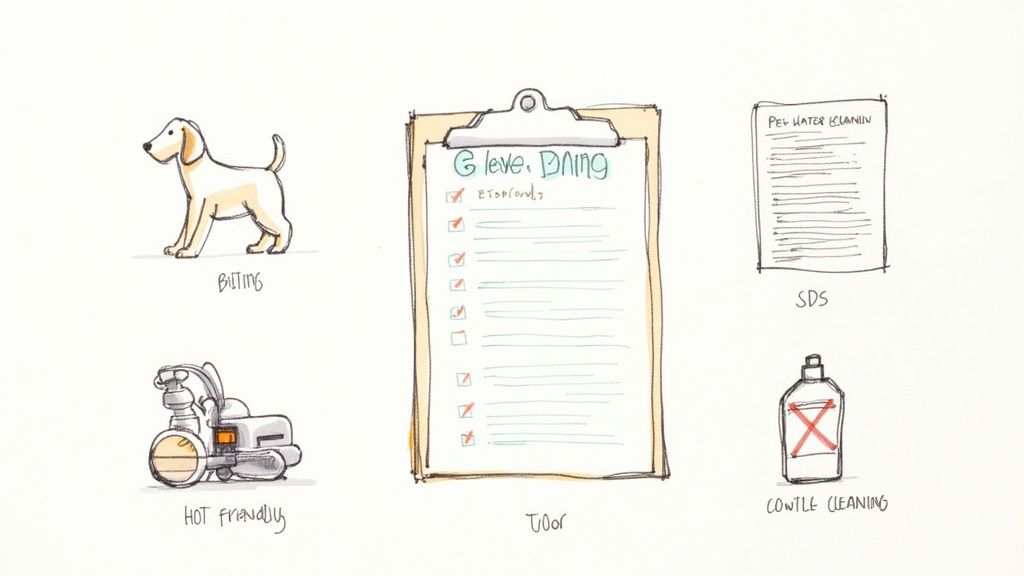
Sometimes, the mess is just too big for a DIY job, and you have to call in the pros. When you do, it's absolutely crucial to find a service that takes your pet's health as seriously as you do. This means knowing what to ask before they ever pull into your driveway.
Start by asking them point-blank about the cleaning solutions they use. A truly pet-friendly company will have nothing to hide. Don't be shy—ask for a list of their primary cleaning agents or even a Safety Data Sheet (SDS) for their go-to products. This document is designed to outline any potential hazards, and their willingness to share it speaks volumes.
Key Questions to Ask Before You Book
Beyond the ingredient list, you need to dig into their actual process. A reputable company should have ready answers for how they keep pets safe from start to finish.
Here are a few questions I always recommend asking:
- What’s your standard procedure for a home with pets? Do they need to be crated or tucked away in another room?
- What kind of equipment are you using? Do you offer a low-moisture cleaning option? (This is a big one for faster, pet-safe drying times).
- Are your cleaning products pH-neutral and free of harsh stuff like ammonia or chlorine?
A major red flag is any company that gets vague about their ingredients or tries to push heavy-duty "deodorizers." These products often just mask smells with powerful fragrances that can be a real nightmare for a pet's respiratory system.
Choosing a professional cleaner is all about trust. If a company is open and honest about its pet-safe protocols, that’s a great sign they care about the health of your entire family.
Got Questions About Safe Carpet Cleaning?
Look, even after you've done your research, some specific questions always come up, especially when you're trying to keep your home clean without putting your pets at risk. I get these all the time, so I've put together some straight answers to the most common ones.
Is a Vinegar and Water Mix Really Safe for My Carpet?
For the most part, yes. A simple 50/50 mix of white vinegar and water is a solid, pet-safe choice for synthetic carpets, like the nylon or polyester found in most homes. But—and this is a big but—you must do a spot test in a closet or under a sofa first.
Some natural fibers, especially wool, can have a bad reaction to acid. The same goes for certain carpet dyes. The strong vinegar smell, by the way, is totally harmless to your pets and will fade completely once it's dry. Just make sure you're using standard white distilled vinegar, not that super-concentrated "cleaning vinegar," which is way too harsh.
How Often Should I Get Carpets Deep Cleaned If I Have Pets?
In a house with four-legged family members, I always recommend a professional deep cleaning every 6 to 12 months. That's the sweet spot for pulling out all the deep-down dander, allergens, and general grime that your vacuum just can't touch.
Of course, that schedule goes out the window when there's an accident. You need to jump on those messes and spot-clean them immediately. If you don't, the stain and the odor will work their way deep into the carpet pad, and then you've got a much bigger problem.
The real secret is being consistent. Professional cleaning handles the deep-seated allergens, while you tackle the day-to-day accidents. It's that one-two punch that keeps your home healthy for everyone.
Can I Add Essential Oils to My DIY Cleaner for a Nice Scent?
Please don't do this. I know it's tempting to make your cleaner smell great, but many popular essential oils are actually toxic to pets if they lick or inhale them, even in tiny amounts.
Stay far away from these oils in particular:
- Tea Tree
- Eucalyptus
- Citrus (lemon, orange)
- Pine
If you want a safe way to freshen things up, just sprinkle some baking soda over the dry carpet. Let it sit for about 20 minutes to soak up any odors, then give it a good, thorough vacuuming. Once the baking soda is all up, it's perfectly safe for your pets to come back in.
Ready for a professional clean that’s tough on stains but gentle on your pets? Citrus Carpet Cleaning Buford uses a low-moisture, citrus-based method that leaves no sticky residue behind. Get your free "EXACT-imate" today at https://citruscarpetcleaningatlanta.com.

